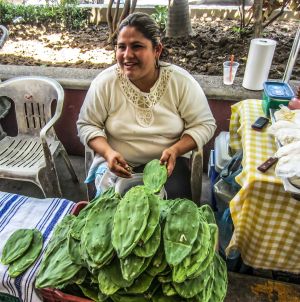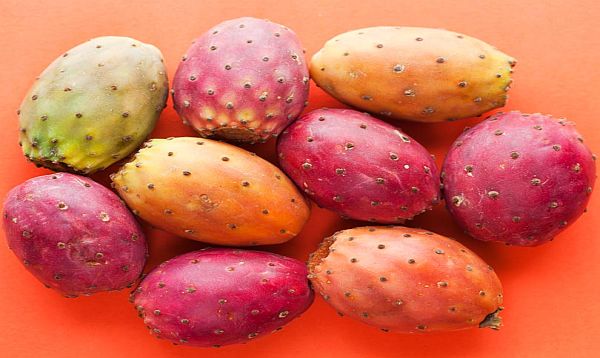Puerto Vallarta, Mexico - Dulce Maria Morales sits at our daily market removing the spines from nopal cactus pads (prickly pear cactus) to prepare them for sale. She and her family have been part of this market for years.
When I first came to Mexico, I asked her what to do with these lovely green pads. Now, after many meals which have included various preparations, I love this food. I have eaten it raw, in green juices, chopped as a salad with onions and tomatoes, mixed with scrambled eggs, steamed with rice and mole, and added to stews. If you do not like its slightly mucilaginous texture then eating it grilled is best.
 |
The nopal cactus is important in the history of Mexico. Thought to have been domesticated over 9000 years ago, it has been discovered as part of the Mayan and Aztec cultures.
The symbols on the Mexican flag include the nopal cactus. This symbology goes far back into Mexican history. The first flag was used in 1821 during the War for Independence which began in 1810.
The name 'nopal' comes from the indigenous Nahuatl language and means "tree that is of pads" due to the shape of the plant.
There are over 8000 nopal farmers in Mexico, mostly in the arid central valley. In addition to producing nopal for consumption by people and animals, some of these farms work to produce an insect that lives on the cactus and can be dried and processed into the natural carmine dye, also known as cochineal.
It takes about 80,000 to 100,000 insects to make one kilogram of cochineal dye, which yields shades of red, crimson, and scarlet, depending on the material being dyed. Mexico has had a monopoly on this dye since when the Mayans used it to color wool and cotton fabrics that were made into clothing and blankets.
After the War of Independence of 1812 however, this monopoly declined as other countries, specifically Spain, Guatemala, and North Africa began their own productions. Over the years, the popularity of cochineal waned due to the invention of synthetic dyes.
Some towns in the Mexican state of Oaxaca are still working in handmade textiles using this cochineal dye. Its use is beginning to increase however as many commercial synthetic red dyes and food colorings have been found to be carcinogenic.
For more information about cochineal, along with an extensive bibliography, click HERE. If you would like to meet Dulce Maria, join me on one of my Puerto Vallarta Walking Tours.
 Sandra Cesca has traveled the world, but found herself returning to Mexico more and more. She moved to Puerto Vallarta in 2008 and never looked back. She currently offers eight different Puerto Vallarta Walking Tours, which include history, architecture, culture, artisanal crafts and ecology. Her photos and articles can be found on puertovallartawalkingtours.com; yourculturalinsider.com; sandracescaphotography.com; Instagram and Facebook. She can be contacted at sandra.learn.vallarta(at)gmail.com; or sandra.cesca.photography(at)gmail.com.
Sandra Cesca has traveled the world, but found herself returning to Mexico more and more. She moved to Puerto Vallarta in 2008 and never looked back. She currently offers eight different Puerto Vallarta Walking Tours, which include history, architecture, culture, artisanal crafts and ecology. Her photos and articles can be found on puertovallartawalkingtours.com; yourculturalinsider.com; sandracescaphotography.com; Instagram and Facebook. She can be contacted at sandra.learn.vallarta(at)gmail.com; or sandra.cesca.photography(at)gmail.com.


